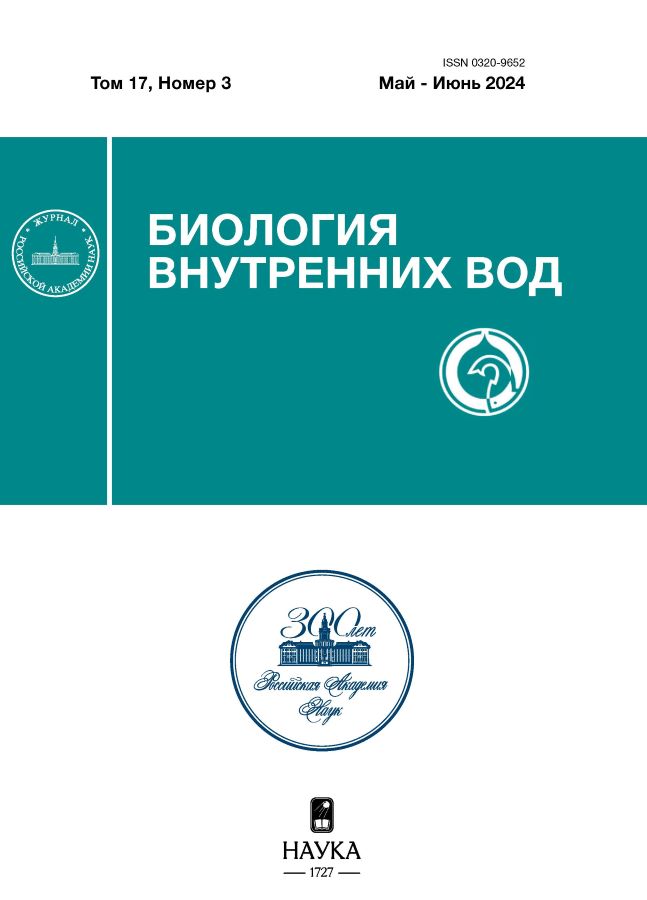The Ability of Gastropods of Lake Baikal to the Feeding and Excretion of Microplastic Particles with Different Morphological Structures
- Authors: Biritskaya S.A.1, Dolinskaya E.M.1, Maslennikova M.A.1, Bukhaeva L.B.1, Pushnitsa V.A.1, Ermolaeva Y.K.1, Lavnikova A.V.1, Golubets D.I.1, Nazarova S.A.2, Karnaukhov D.Y.1, Silow E.A.1
-
Affiliations:
- Irkutsk State University
- Zoological Institute Russian Academy of Sciences
- Issue: Vol 17, No 3 (2024)
- Pages: 452-457
- Section: ВОДНАЯ ТОКСИКОЛОГИЯ
- URL: https://kazanmedjournal.ru/0320-9652/article/view/670112
- DOI: https://doi.org/10.31857/S0320965224030098
- EDN: https://elibrary.ru/ZPKIQE
- ID: 670112
Cite item
Abstract
Studies of the pollution of Lake Baikal with microplastic particles have been started quite recently. Almost all research is focused on the assessment of surface water pollution, while the impact of microplastics on Baikal organisms remains unexplored. We conducted a laboratory experiment involving three species of gastropod mollusks, the Palearctic Lymnaea stagnalis (L., 1758) and Radix auricularia (L., 1758), as well as the Baikal endemic Benedictia baicalensis (Gerstfeldt, 1859). Two types of microplastics were used in the experiment: fragments of polystyrene and polyester fibers, prepared independently in the laboratory. These plastic particles, along with the food mixture, were placed in aquariums with mollusks. In total, as a result of the experiment, 386 preparations with mollusk excrement were obtained, of which 144 preparations were for the Radix auricularia species, 176 for the Lymnaea stagnalis species, and 67 for the Benedictia baicalensis species, the experiment with the latter species was carried out only with microplastic fragments. All preparations were analyzed according to the degree of fluorescence. The data were statistically processed using Spearman’s rank correlation coefficient. The data obtained allowed us to conclude that gastropods of these species are able to absorb microplastic particles and remove them from the body. However, the rate of removal of microplastic particles from the body of a mollusk is species-specific, and also directly depends on the morphological structure of microplastic particles.
Full Text
About the authors
S. A. Biritskaya
Irkutsk State University
Email: karnaukhovdmitrii@gmail.com
Russian Federation, Irkutsk
E. M. Dolinskaya
Irkutsk State University
Email: karnaukhovdmitrii@gmail.com
Russian Federation, Irkutsk
M. A. Maslennikova
Irkutsk State University
Email: karnaukhovdmitrii@gmail.com
Russian Federation, Irkutsk
L. B. Bukhaeva
Irkutsk State University
Email: karnaukhovdmitrii@gmail.com
Russian Federation, Irkutsk
V. A. Pushnitsa
Irkutsk State University
Email: karnaukhovdmitrii@gmail.com
Russian Federation, Irkutsk
Ya. K. Ermolaeva
Irkutsk State University
Email: karnaukhovdmitrii@gmail.com
Russian Federation, Irkutsk
A. V. Lavnikova
Irkutsk State University
Email: karnaukhovdmitrii@gmail.com
Russian Federation, Irkutsk
D. I. Golubets
Irkutsk State University
Email: karnaukhovdmitrii@gmail.com
Russian Federation, Irkutsk
S. A. Nazarova
Zoological Institute Russian Academy of Sciences
Email: karnaukhovdmitrii@gmail.com
Russian Federation, St. Petersburg
D. Yu. Karnaukhov
Irkutsk State University
Author for correspondence.
Email: karnaukhovdmitrii@gmail.com
Russian Federation, Irkutsk
E. A. Silow
Irkutsk State University
Email: karnaukhovdmitrii@gmail.com
Russian Federation, Irkutsk
References
- Климова Я.С., Чуйко Г.М., Песня Д.С. и др. 2020. Биомаркеры окислительного стресса пресноводных двустворчатых моллюсков (обзор) // Биология внутр. вод. № 6. С. 612. https://doi.org/10.31857/S0320965220060091
- Русинек О.Т., Тахтеев В.В., Ходжер Т.В. и др. 2012. Байкаловедение. Новосибирск: Наука.
- Abidli S., Lahbib Y., el Menif N.T. 2019. Microplastics in commercial molluscs from the lagoon of Bizerte (Northern Tunisia) // Mar. Pollut. Bull. V. 142. P. 243. https://doi.org/10.1016/j.marpolbul.2019.03.048
- Akindele E.O., Ehlers S.M., Koop J.H.E. 2019. First empirical study of freshwater microplastics in West Africa using gastropods from Nigeria as bioindicators // Limnologica. V. 78. e125708. Р. 1. https://doi.org/10.1016/j.limno.2019.125708
- Annenkov V.V., Danilovtseva E.N., Zelinskiy S.N. et al. 2021. Submicro- and nanoplastics: How much can be expected in water bodies? // Environ. Pollut. V. 278. e116910. P. 1. https://doi.org/10.1016/j.envpol.2021.116910
- Ehlers S.M., Maxein J., Koop J.H.E. 2020. Low-cost microplastic visualization in feeding experiments using an ultraviolet light-emitting flashlight // Ecol. Res. V. 35. P. 265. https://doi.org/10.1111/1440-1703.12080”10.1111/ 1440-1703.12080
- Horton A.A., Newbold L.K., Palacio-Cortés A.M. et al. 2020. Accumulation of polybrominated diphenyl ethers and microbiome response in the great pond snail Lymnaea stagnalis with exposure to nylon (polyamide) microplastics // Ecotoxicol. Environ. Saf. V. 188. e109882. Р. 1. https://doi.org/10.1016/j.ecoenv.2019.109882
- Il’ina O.V., Kolobov M.Y., Il’inskii V.V. 2021. Plastic pollution of the coastal surface water in the middle and southern Baikal // WARE. V. 48(1). P. 56. https://doi.org/10.1134/S0097807821010188
- Karnaukhov D., Biritskaya S., Dolinskaya E. et al. 2020. Pollution by macro- and microplastic of large lacustrine ecosystems in Eastern Asia // Pollut. Res. V. 36(2). Р. 440.
- Karnaukhov D., Biritskaya S., Dolinskaya E. et al. 2022. Distribution features of microplastic particles in the Bolshiye Koty Bay (Lake Baikal, Russia) in winter // Pollution. V. 8(2). Р. 435. https://doi.org/10.22059/POLL.2021.328762.1159
- Mateos-Cárdenas A., O’Halloran J., van Pelt F.N.A.M. et al. 2020. Rapid fragmentation of microplastics by the freshwater amphipod Gammarus duebeni (Lillj.) // Sci. Rep. V. 10. e12799. P. 1. https://doi.org/10.1038/s41598-020-69635-2
- Meyer M.F., Ozersky T., Woo K.H. et al. 2022. A unified dataset of colocated sewage pollution, periphyton, and benthic macroinvertebrate community and food web structure from Lake Baikal (Siberia) // Limnol. Oceanogr. Lett. V. 7. Р. 62. https://doi.org/10.6073/pasta/9554b7f19ddd4a614e854f18be978dca
- Moore M.V., Yamamuro M., Timoshkin O.A. et al. 2022. Lake-wide assessment of microplastics in the surface waters of Lake Baikal, Siberia // Limnology. V. 23. P. 265. https://doi.org/10.1007/s10201-021-00677-9
- Naji A., Nuri M., Vethaak A.D. 2018. Microplastics contamination in molluscs from the northern part of the Persian Gulf // Environ. Pollut. V. 235. Р. 113. https://doi.org/10.1016/j.envpol.2017.12.046
Supplementary files











